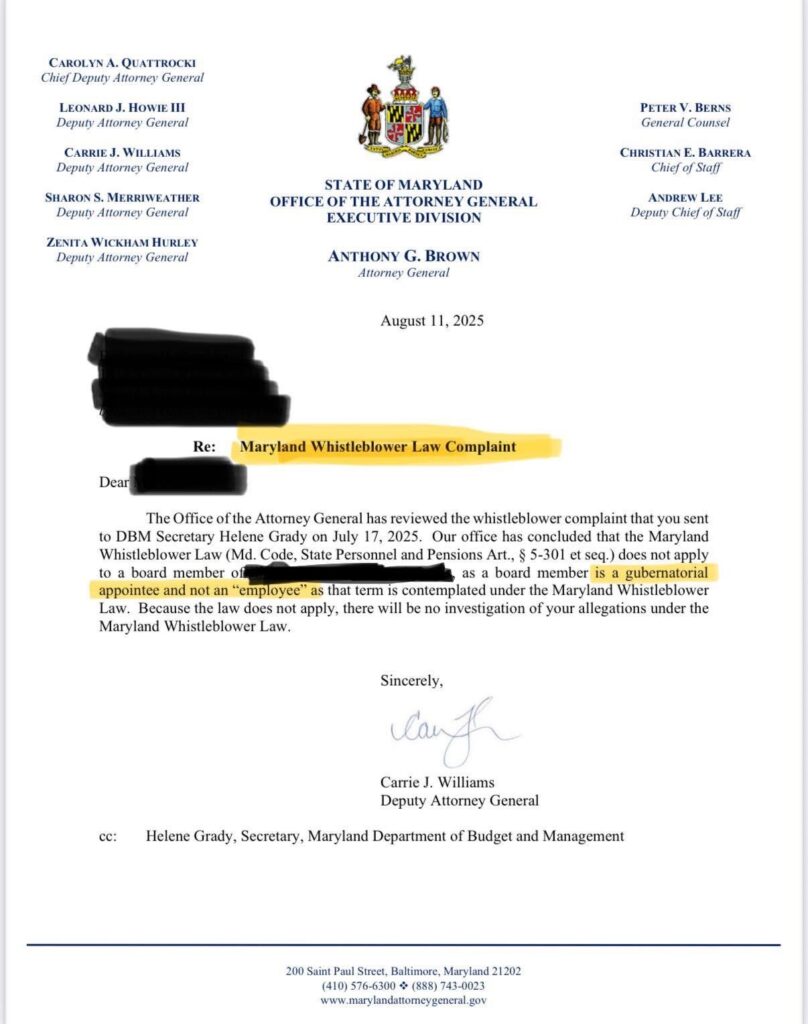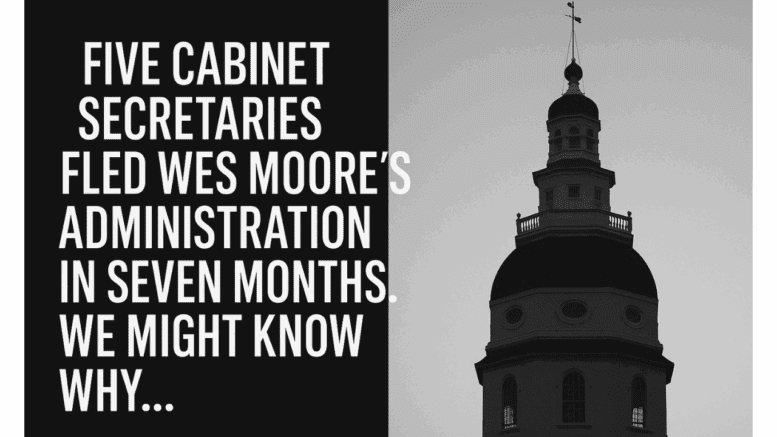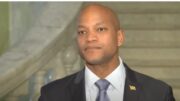In the marble halls of the State House, where whispered conversations often matter more than public pronouncements, a curious document circulated among Governor Wes Moore’s appointees this August.
Not a policy memo or legislative strategy, but a warning: You have no whistleblower protection.
Deputy Attorney General Carrie J. Williams may not have intended her August 11, 2025, letter for public consumption.

Yet its emergence on social media – complete with stark warnings that gubernatorial appointees can “expect retaliation with impunity” – provides the missing piece to a puzzle that has confounded Maryland political observers all year:
Why have five cabinet secretaries departed Maryland Governor Wes Moore’s administration in rapid succession?
The answer, it appears, lies not in what these officials could say, but perhaps in what they couldn’t.
Wes Moore’s Cabinet Exodus That Nobody’s Discussing
Gov. Moore has 23 total cabinet members.
Five cabinet secretaries have resigned so far in 2025.
For all you math kids, that’s a 22% turnover rate in just seven months.
1) Kevin Anderson (Commerce)
Mr. Anderson “transitioned” to an advisory role in January after two years of “success.” The administration did not explain why a successful secretary needed to be transitioned.
Transition Date: January 2025.
2) Laura Herrera Scott (Health)
Ms. Herrera Scott resigned in February amid cascading crises at state psychiatric facilities and a brutal budget fight over $200 million in cuts to state disability services.
They described the timing as allowing her successor to avoid the budget debate.
Departure Date: February 28, 2025.
3) Anthony Woods (Veterans)
The former BCG’er departed in May for a technology startup gig, a move announced with minimal fanfare despite Mr. Woods’ high-profile advocacy work.
Departure Date: May 11, 2025.
4) Vincent Schiraldi (Juvenile Services)
The most controversial exit in June, with the Governor and Secretary offering contradictory accounts.
Moore claimed he “ordered” the resignation; Schiraldi insisted he’d planned to leave.
Someone isn’t telling the truth.
Last Day: June 20, 2025 (confirmed by Schiraldi in interviews).
5) Paul Wiedefeld (Transportation)
Mr. Wiedefeld left in August, citing his 70th birthday, though he immediately assumed the presidency of a regional transportation association — hardly the retirement he suggested.
Five cabinet members.
Seven months.
Each departure was carefully managed, communicated, and progressed before questions could crystallize.
Departure Date: August 1, 2025.
The Legal Architecture of Silence
Here’s where a lawyer’s eye catches what a political reporter might miss: Maryland’s whistleblower statute, in its elegant simplicity, creates an elegant trap.
The law protects “employees” who report waste, fraud, and abuse.
But gubernatorial appointees – board members, commissioners, cabinet secretaries – aren’t “employees” under the statutory definition.
Meanwhile, a mid-level clerk in their department enjoys full protection as a whistleblower.
Here’s Maryland State Government’s Current Retaliation Reality:
- There is no Administrative Remedy: Gubernatorial appointees cannot file complaints with the State Personnel Office.
- No Judicial Recourse: Courts lack jurisdiction without statutory authorization.
- There are no Damages Available: Even if wrongful, there is no statutory basis for recovery.
- It’s a Chilling Effect: Legally documented and predictable.
The Crematory, The Hospital, and The Question Unasked
The pattern becomes more disturbing when we examine specific cases.
Take the Board of Morticians and Funeral Directors scandal that erupted in January.
Three board members “resigned” after Governor Moore offered them, in the words of former President Michele Kutta, a choice to “resign or be removed.”
The precipitating scandal – abysmal conditions at Heaven Bound Cremation Services – raises an uncomfortable question:
How long did board members know about these conditions? And if they knew, why didn’t they act sooner?
The answer might lie in that August letter. Without whistleblower protection, board members who raised early alarms risked their positions.
Better to wait, hope the problem resolves itself, or let someone else take the risk.
The same dynamic may explain the cascading failures at Clifton T. Perkins Hospital Center, where patient abuse and violence festered for years.
How many of Wes Moore’s gubernatorial appointees saw warning signs but calculated that speaking up carried more personal risk than staying silent?
The Wes Moore Paradox
Maryland Governor Wes Moore ran on a platform of transparency and accountability, promising to “leave no one behind.”
Yet his administration now presides over a system where those best positioned to ensure accountability apparently operate without the most basic employment protection.
Maryland political insiders recognize the irony: an administration that champions protecting vulnerable populations has left its own senior officials vulnerable to retaliation for doing exactly what good governance demands – speaking truth to power.
This isn’t a partisan issue.
The whistleblower gap existed under Republican Governor Larry Hogan and will likely persist under Moore’s successor, perhaps a familiar name: Larry Hogan, unless the General Assembly acts.
But the concentration of Moore administration cabinet departures in 2025, coupled with the AG’s formal determination, suggests the theoretical problem has become practically acute.
The Schiraldi Tell
The most unmistakable evidence that something systemic is amiss comes from the Schiraldi departure.
When a Governor and his Cabinet secretary cannot agree on whether a resignation was voluntary or ordered, we’re not witnessing mere miscommunication.
We’re seeing the collapse of the polite fiction that typically masks forced departures.
Schiraldi, in his Baltimore Sun op-ed, came as close as any departing official to lifting the veil, writing that “history doesn’t smile on people who say they were only following orders as they operationalized human rights abuses.”
Strong words from a former secretary about his own department’s operations.
We’re not speculating. Schiraldi literally wrote that he left because he could no longer be complicit in what he saw as violations, but couldn’t fix from inside because speaking out = termination.
But notice what Schiraldi couldn’t say while in office. His concerns about Maryland’s juvenile justice system – what he called “human rights abuses” – only emerged after his departure.
While serving, Schiraldi faced the same calculation as all appointees: speak out and lose your platform, or stay silent and remain complicit.
It’s a governmental omertà – that Sicilian code of silence born from fear of retribution – except here it’s enshrined not in tradition but in the cold mechanics of Maryland employment law.
The Pattern Tells the Story
Forget the raw statistics.
Focus instead on the pattern: Five cabinet departures, all concentrated in 2025, each following significant controversy within their departments.
- Anderson left after two years of “success” with no explanation.
- Herrera Scott departed amid psychiatric hospital crises and disability funding battles.
- Woods exited quietly despite high-profile veteran advocacy.
- Schiraldi‘s resignation spawned conflicting narratives between him and the Governor.
- Wiedefeld claimed retirement while immediately taking another leadership role.
This isn’t normal attrition spread across a gubernatorial term – it’s a clustered exodus occurring precisely when the Attorney General confirmed what these officials likely already knew: that Maryland’s highest-ranking appointees operate without the most basic protection afforded to entry-level clerks.
When those with the most significant visibility into government operations consistently choose exit over voice, when departures require carefully managed messaging and conflicting explanations, when truth only emerges in post-employment op-eds, we’re not witnessing a personnel problem.
We’re watching the systematic failure of a legal framework that prioritizes executive control over governmental accountability.
The Systematic Simple Solution That’s Not Hard To Figure Out
The fix is embarrassingly simple: Amend the Maryland Whistleblower Law to include gubernatorial appointees explicitly.
The General Assembly could pass such legislation in a single session. The fact that they haven’t suggests either legislative oversight or something more troubling – a bipartisan consensus that governors need unlimited control over their appointees.
But unlimited control and accountable government cannot coexist. Every organization needs internal critics, especially the government.
When we silence those critics through structural intimidation rather than substantive rebuttal, we don’t eliminate problems – we simply drive them underground until they explode into scandal.
The View from 2026
As Maryland approaches the 2026 gubernatorial election, candidates from both parties will naturally promise reform, transparency, and accountability.
The savvy Maryland voter might ask a simpler question: Will you protect the people who protect the public by reporting wrongdoing?
Because until Maryland extends whistleblower protection to all public servants – not just those below a certain pay grade or appointment level – we’ll continue to see this pattern: Quiet departures, managed messaging, and problems that fester until they become crises.
The Moore administration’s cabinet exodus isn’t just a personnel problem; it’s seemingly a structural indictment of a system that prioritizes power over people, silence over speech, and comfortable fictions over uncomfortable truths.
The old gumshoe State House basement reporters will know this one: “If your mother says she loves you, check it out.”
But in Maryland government, it seems, if you check it out and find she doesn’t, you’d better dummy up – especially if you’re a gubernatorial appointee.
The real scandal isn’t that five cabinet officials left in seven months. It’s that Maryland law ensured they couldn’t tell us why.





